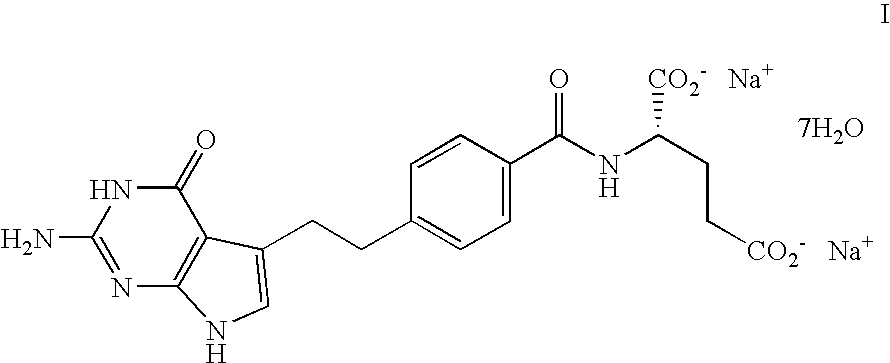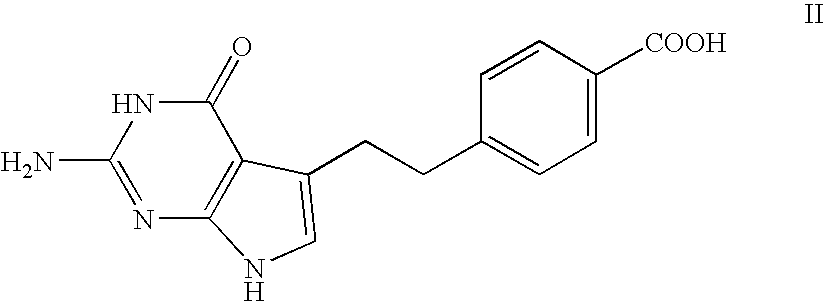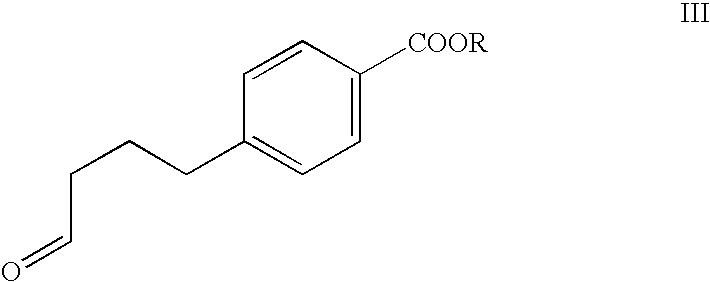Processes for preparing intermediates of pemetrexed
a technology of pemetrexed and intermediates, which is applied in the field of processes for preparing intermediates of pemetrexed, can solve the problems of aldehyde intermediate, not very suitable for industrial production, and the route of synthesis
- Summary
- Abstract
- Description
- Claims
- Application Information
AI Technical Summary
Problems solved by technology
Method used
Image
Examples
example 1
Preparation of 4-(4-benzonitrile)-butanal (compound IX)
[0079]4-bromobenzonitrile (20 g, 109.87 mmol), lithium acetate (12.33 g, 120.86 mmol), lithium chloride (13.97 g, 329.62 mmol), and tetrabutylammonium chloride (14.35 g, 51.64 mmol) were dissolved in 274 ml of dimethylformamide. The resulting solution was degassed with a subsurface nitrogen purge. 3-Buten-1-ol (9.51 g, 11.30 mL, 131.85 mmol) and palladium acetate (672 mg, 2.75 mmol) were added to the solution and the reaction mixture was heated to 65° C., while stirring under nitrogen atmosphere, for approximately 17 h. The progress of the reaction was monitored by HPLC by the amount of starting 4-bromobenzonitrile remaining. The reaction was deemed to be complete when there was <0.4% 4-bromobenzonitrile remaining, as determined by HPLC. After the reaction was complete, the reaction mixture was allowed to cool to 25° C. spontaneously and water (200 mL) and ethyl acetate (200 mL) were added. The reaction mixture was then stirred ...
example 2
Preparation of 1-Hydroxy-2-bromo-4-(4-benzonitrile) butanal (compound X)
[0080]The ethyl acetate solution of 4-(4-benzonitrile)-butanal prepared in example 1 was evaporated three times after consecutive additions of acetonitrile in portions (3×70 mL), until substitution of ethyl acetate with acetonitrile. Nitrogen was bubbled through the resulting solution for 10 minutes, the mixture was cooled to 5° C. with a cooling bath, and bromine (17.6 g, 5.6 mL, 109.87 mmol) was added to obtain an orange solution. The solution was then removed from the cooling bath and was stirred for additional 2 hours. Water (100 mL) and sodium bisulfite (1.1 g, 10.90 mmol) were added in order to quench the remaining bromine and the resulting mixture was stirred for 1 hour. The mixture was then partitioned between methylene chloride (100 mL) and an additional quantity of water (50 mL). The organic phase was separated and concentrated at 37° C. to a volume of 210 mL. The resulting solution of the title compou...
example 3
Preparation of 4-[2-(2-amino-4,7-dihydro-4-oxo-3H-pyrrolo[2,3-d]pyrimidin-5-yl)ethyl]benzonitrile (compound VI)
[0081]To 70 mL of the methylene chloride solution from example 2, containing 1-hydroxy-2-bromo-4-4(4-cyanophenyl)butanal, were added water (60 mL) and sodium acetate (4.20 g, 51.19 mmol). Nitrogen was bubbled through the mixture for 10 minutes and 2,4-diamino-6-hydroxy pyrimidine (3.20 g, 25.37 mmol) was added. The mixture was heated at 40° C., under nitrogen atmosphere, for 2 hours and then was allowed to cool to 24° C. spontaneously. The suspension was stirred at 24° C. for 42 hours, left standing for 2 hours without stirring and filtered. The collected solid was washed with a 1:1 mixture of acetonitrile and water (70 mL). The filter cake was dried under vacuum for 2 hours at 40° C. to yield 1.0 g of the title compound as a white powder (HPLC purity 95.8%).
PUM
| Property | Measurement | Unit |
|---|---|---|
| Temperature | aaaaa | aaaaa |
| Temperature | aaaaa | aaaaa |
| Temperature | aaaaa | aaaaa |
Abstract
Description
Claims
Application Information
 Login to View More
Login to View More - R&D
- Intellectual Property
- Life Sciences
- Materials
- Tech Scout
- Unparalleled Data Quality
- Higher Quality Content
- 60% Fewer Hallucinations
Browse by: Latest US Patents, China's latest patents, Technical Efficacy Thesaurus, Application Domain, Technology Topic, Popular Technical Reports.
© 2025 PatSnap. All rights reserved.Legal|Privacy policy|Modern Slavery Act Transparency Statement|Sitemap|About US| Contact US: help@patsnap.com



